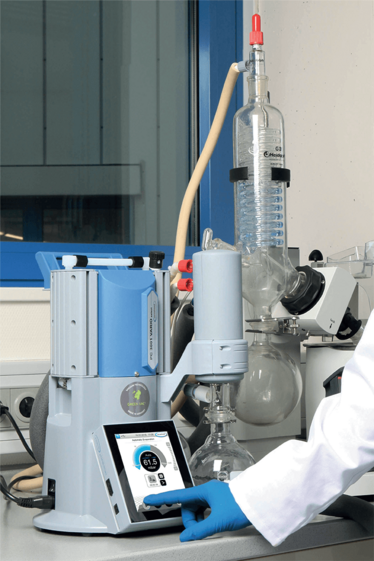Optimizing Extractions with Vacuum Control
How maintaining the “right” balance of evaporation and condensation during extraction – using intelligent vacuum control – is the key to maximizing product yield and throughput
sponsored by BrandTech Scientific, Inc.

Vacuum plays an important role throughout the cannabis extraction process, including separating substances through evaporation. Using proper vacuum control in your extraction process can maximize yield, quality, and throughput.
Rotary evaporators (or rotavaps) are well-established tools for extracting a substance from a multi-component solution. Rotavaps separate solvents through evaporation, which leaves the substance of interest behind in a rotating flask. The solvent vapors flow through the rotavap until they reach the cold surface of the condenser. Once those vapors come in contact with the condenser, they recondense and flow down into a collection flask, where they can be collected and reused later. This process is a balancing act between the rate of evaporation in the rotating flask and the rate of condensation at the condenser.
A balancing act
In a production setting, it can be challenging to achieve a balance between evaporation and condensation that brings high yield, high product quality, and high throughput. The rates of evaporation and condensation are dictated by a number of material-specific parameters, such as vapor pressure, as well as process parameters, such as temperature, pressure (vacuum), and surface area. Of these process parameters, temperature and pressure have the greatest impact.
Notably, temperature control brings about slow changes, whereas changes to the vacuum level inside the rotavap result in almost instantaneous changes. For this reason, vacuum-based control is the preferred way to maintain the “right” balance between evaporation and condensation to maximize yield, quality, and throughput.
Often, process development begins with a sole focus on maximizing throughput by maximizing the rate of evaporation without regard to the impact on yield, quality, or cost. For example, the rotavap bath temperature is often set relatively high and the vacuum pump is used to provide the deepest vacuum possible. This approach imposes a heavy load on both the condenser and the vacuum pump, and consequently has several pitfalls – the compound of interest can degrade or break down entirely when exposed to high temperature, for example, reducing product quality. And if the vacuum is too deep, samples can bump and foam, lowering the process yield. And throughput, as measured in terms of sellable product produced per hour of operation, can drop because of both low yield and long process times. Process time increases significantly as the rates of evaporation and condensation become unbalanced. When the rate of condensation is lower than the rate of evaporation, the excess solvent vapor must flow through the vacuum pump. In turn, this requires the use of an oversized pump and results in lower solvent recovery while also driving up costs.
Controlling the vacuum with exacting precision
Two different methods are commonly used to overcome these issues and achieve the necessary vacuum control. The first approach is referred to as two-point control and can be used with any appropriately sized vacuum pump. A control module is combined with a solenoid valve and a vacuum sensor. Based on the sensor reading, the control module opens and closes the valve to hold the pressure level close to the user-defined set point. Commercially available controllers can offer additional, advanced capabilities. For example, VACUUBRAND’s VACUU·SELECT® complete vacuum controller comes configured with many common lab vacuum applications that can be selected at the touch of a button. The VACUU·SELECT controller can be configured to hold a specific, user-adjustable vacuum level. Or, simply by selecting a different application, the controller can be set to automatically detect the first solvent boiling point and then hold the vacuum at that level.
However, processes can be optimized further, with a more precise approach to vacuum control that constantly adjusts the pump motor speed to respond instantaneously to the ever-changing conditions inside the rotavap. This is the control scheme used on VACUUBRAND’s VARIO® select pumps, which allows the user to control the vacuum level with exacting precision.
The VARIO select pump line integrates the VACUU·SELECT controller and its broad array of preconfigured vacuum applications. And by combining the advanced capabilities of the VACUU·SELECT controller with the variable motor speed control, the user can fully automate extraction processes at the touch of a button. The controller continuously adjusts the pumping speed and vacuum level to maintain the correct balance between solvent evaporation and condensation. This “Automatic Evaporation” application ensures that the process is completed as fast as possible – all while minimizing sample loss from bumping and foaming, producing repeatable, reliable results. Perhaps best of all, automation – by definition – allows the evaporation process to run unattended, freeing up time otherwise spent on labor-intensive work.
Maintaining the proper balance between solvent evaporation and condensation through vacuum control – given that extractions and distillation processes are sensitive to changes in vacuum level, and therefore respond rapidly – is key to optimizing extractions and achieving high yield and throughput. VACUUBRAND’s VACUU·SELECT complete controllers and VARIO select pumps make it easy – and cost-effective – to implement the necessary vacuum control, and bring extraction processes into balance.












